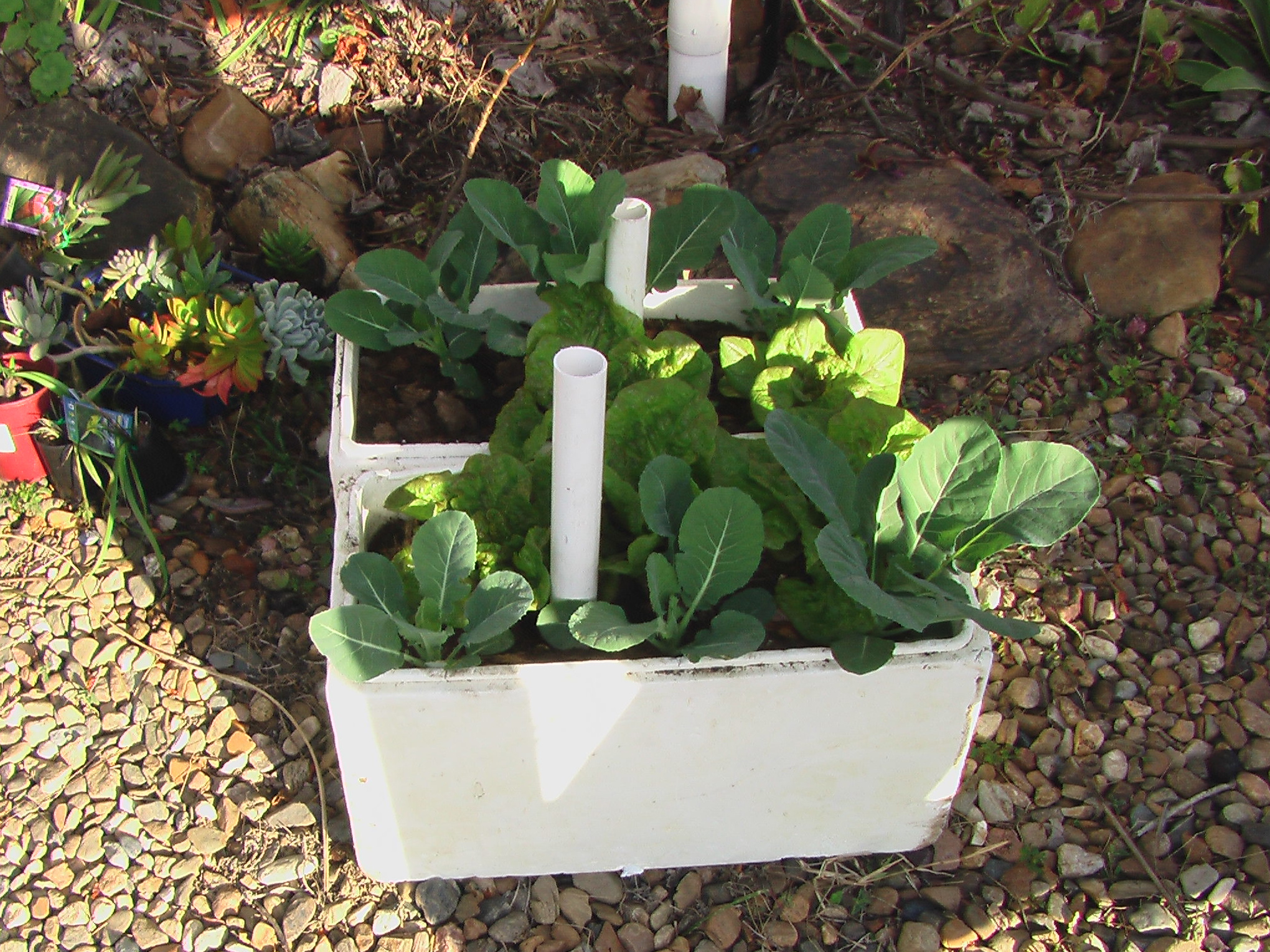Wicking boxes and beds are for people who like to grow at least some healthy vegetables but are short of time, water, suitable space or money. With wicking boxes, they can grow healthy vegetables on balconies, concrete surfaces, near trees and on heavy clay soils.
Wicking refers to water moving sideways and upwards without any external support due to its molecular structure. For the science-minded, wicking happens because a molecule of water has a positive and a negative end. These ends attract each other, making water molecules stick together. The power that links the molecules is not very strong but is sufficient to pull the water up to 30cm.
Good soil, cloth, and other materials contain countless small channels called capillaries. These very small and connected channels make it possible for water to move up and sideways. Without them, or if they are blocked, wicking cannot happen. To see this in action, hang a wet towel half in and half out of a bucket of water, and watch as water slowly drips onto the surface. Wicking in soil works similarly but at a slower rate.
In some soils, wicking can draw water upwards to 300cm. This allows for a reservoir of water inside beds or boxes, enabling bottom-up watering in addition to the traditional surface-down method.
What Are Wicking Beds and Boxes?
Wicking beds and boxes are the containers we use to grow plants in a way which maximises water efficiency and provides an environment for optimal growth. They are waterproof or lined with a waterproof liner and have an overflow to allow for excess water to drain out. At the bottom of the container is a pipe filled with water that, with the soil around it, forms a reservoir of water that will wick up and water the roots. There is an overflow at the top of the pipe to drain excess water from rain or over-watering.
Advantages
Wicking beds and boxes offer numerous benefits:
- A built-in water reservoir provides plants with consistent moisture over longer periods, reducing the need for frequent shallow watering. The water is kept in the root zone. This encourages root development and, with proper nutrition, ensures healthy soil and plants. (See our guide to making your own healthy soil)
- Optimised water use: since they are self-contained, no water percolates below the box, and tree roots cannot invade the beds. Over-watering is prevented by the overflow.
- Less frequent watering: allows for flexible schedules, making it a convenient weekend task, especially for busy individuals.
- Suitable for various locations: they can be placed near trees, on heavy clay soils, concrete, balconies, or even on tables.
What Can Be Used to Make Them?
Wicking beds can be purchased, but many sold as ‘wicking boxes’ do not actually wick. Before buying, read our article on the countless ways to make wicking beds and make sure to watch out for many of the common misconceptions and design flaws of commercialised and popularised wicking beds. Proper wicking beds are easy to make. Any container or structure that can be made waterproof with a plastic liner can serve as a wicking bed or box.
To function correctly, a wicking bed requires:
- A 90 mm PVC pipe: half the water is stored add in the reservoir pipe up to the level of the overflow and fills quickly; the other half is held in the soil, which absorbs water slowly.
- A fill pipe: extends to the surface for reservoir refilling.
- An overflow pipe: An overflow pipe at the top of the reservoir pipe through the wall into the outside, to prevent beds and boxes from becoming a swamp during heavy rain or over-watering.
Common Wicking Containers
Styrofoam Boxes
Styrofoam wicking boxes can be placed on tables for easy access. They are portable, durable (lasting over ten years), and help regulate soil temperature. They are also easy to make and often available for free from greengrocers or vegetable wholesalers. (See making a Styrofoam wicking box)
Wicking Tubs
Larger pots and tubs can be converted into wicking containers by adding a plastic liner (if necessary), a 90 mm PVC reservoir pipe, a fill pipe, and an overflow. Black tubs may overheat, so surrounding them with shade cloth can help regulate temperature. Tubs can also be moved easily using a trolley.
Wicking Beds
Wicking beds are permanent structures that come in various shapes, sizes, and materials. (See the countless ways to make wicking beds for examples.)
Key Guidelines
When building your wicking bed, it is important to keep the following essential requirements in mind.
- Soil and mulch should not exceed 400 mm above the water reservoir.
- No plant should be more than 350 mm from an outlet hole in the reservoir pipe.
- A U-shaped reservoir is required for beds wider than 800 mm to ensure even water distribution.
- An overflow pipe should be fitted 100 mm from the bottom to prevent the box from swamping from excess water.
Warnings
Since we introduced wicking beds online 20+ years ago, several incorrect designs have emerged. To avoid these pitfalls, refer to our article on common misconceptions and wrong designs.
One major issue is designs that use stones and cloth to separate soil from the 90 mm PVC pipe. This approach is flawed because:
- The cloth creates an airlock, preventing wicking (air does not wick).
- Stones replace essential soil biology, which is crucial for plant health.
- Water-holding capacity is reduced.
For a detailed explanation of why these designs are ineffective, see the real cost of using cloth and stones in wicking boxes and beds. Disappointingly, even the ABC has promoted these flawed designs.


